key FIAT DOBLO COMBI 2015 2.G Workshop Manual
[x] Cancel search | Manufacturer: FIAT, Model Year: 2015, Model line: DOBLO COMBI, Model: FIAT DOBLO COMBI 2015 2.GPages: 323, PDF Size: 46.77 MB
Page 142 of 323
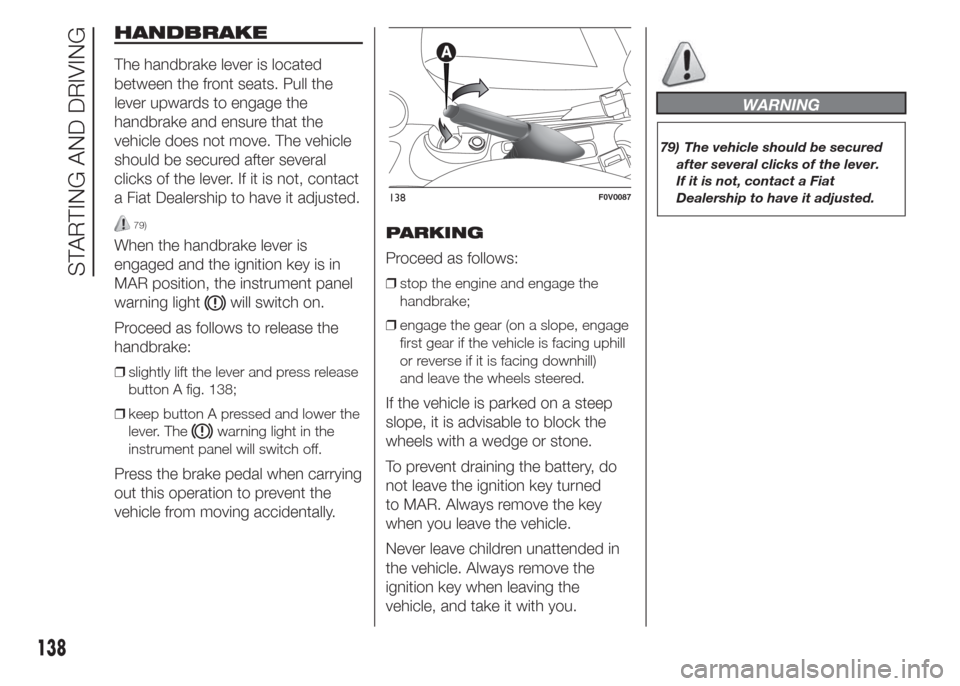
HANDBRAKE
The handbrake lever is located
between the front seats. Pull the
lever upwards to engage the
handbrake and ensure that the
vehicle does not move. The vehicle
should be secured after several
clicks of the lever. If it is not, contact
a Fiat Dealership to have it adjusted.
79)
When the handbrake lever is
engaged and the ignition key is in
MAR position, the instrument panel
warning light
will switch on.
Proceed as follows to release the
handbrake:
❒slightly lift the lever and press release
button A fig. 138;
❒keep button A pressed and lower the
lever. The
warning light in the
instrument panel will switch off.
Press the brake pedal when carrying
out this operation to prevent the
vehicle from moving accidentally.PARKING
Proceed as follows:
❒stop the engine and engage the
handbrake;
❒engage the gear (on a slope, engage
first gear if the vehicle is facing uphill
or reverse if it is facing downhill)
and leave the wheels steered.
If the vehicle is parked on a steep
slope, it is advisable to block the
wheels with a wedge or stone.
To prevent draining the battery, do
not leave the ignition key turned
to MAR. Always remove the key
when you leave the vehicle.
Never leave children unattended in
the vehicle. Always remove the
ignition key when leaving the
vehicle, and take it with you.
WARNING
79) The vehicle should be secured
after several clicks of the lever.
If it is not, contact a Fiat
Dealership to have it adjusted.
138F0V0087
138
STARTING AND DRIVING
Page 145 of 323
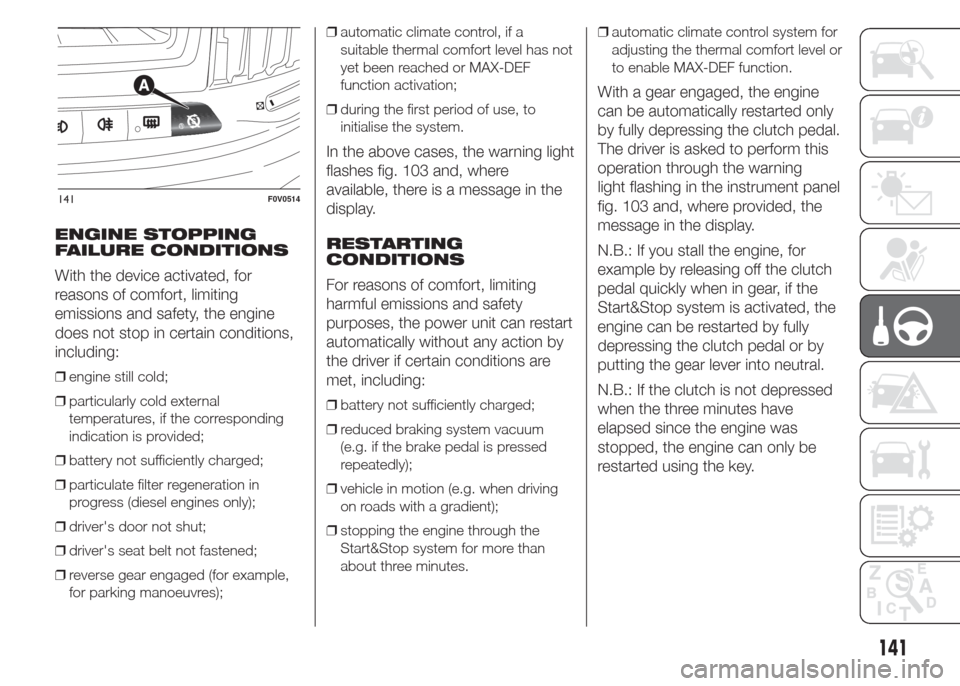
ENGINE STOPPING
FAILURE CONDITIONS
With the device activated, for
reasons of comfort, limiting
emissions and safety, the engine
does not stop in certain conditions,
including:
❒engine still cold;
❒particularly cold external
temperatures, if the corresponding
indication is provided;
❒battery not sufficiently charged;
❒particulate filter regeneration in
progress (diesel engines only);
❒driver's door not shut;
❒driver's seat belt not fastened;
❒reverse gear engaged (for example,
for parking manoeuvres);❒automatic climate control, if a
suitable thermal comfort level has not
yet been reached or MAX-DEF
function activation;
❒during the first period of use, to
initialise the system.
In the above cases, the warning light
flashes fig. 103 and, where
available, there is a message in the
display.
RESTARTING
CONDITIONS
For reasons of comfort, limiting
harmful emissions and safety
purposes, the power unit can restart
automatically without any action by
the driver if certain conditions are
met, including:
❒battery not sufficiently charged;
❒reduced braking system vacuum
(e.g. if the brake pedal is pressed
repeatedly);
❒vehicle in motion (e.g. when driving
on roads with a gradient);
❒stopping the engine through the
Start&Stop system for more than
about three minutes.❒automatic climate control system for
adjusting the thermal comfort level or
to enable MAX-DEF function.
With a gear engaged, the engine
can be automatically restarted only
by fully depressing the clutch pedal.
The driver is asked to perform this
operation through the warning
light flashing in the instrument panel
fig. 103 and, where provided, the
message in the display.
N.B.: If you stall the engine, for
example by releasing off the clutch
pedal quickly when in gear, if the
Start&Stop system is activated, the
engine can be restarted by fully
depressing the clutch pedal or by
putting the gear lever into neutral.
N.B.: If the clutch is not depressed
when the three minutes have
elapsed since the engine was
stopped, the engine can only be
restarted using the key.
141F0V0514
141
Page 146 of 323
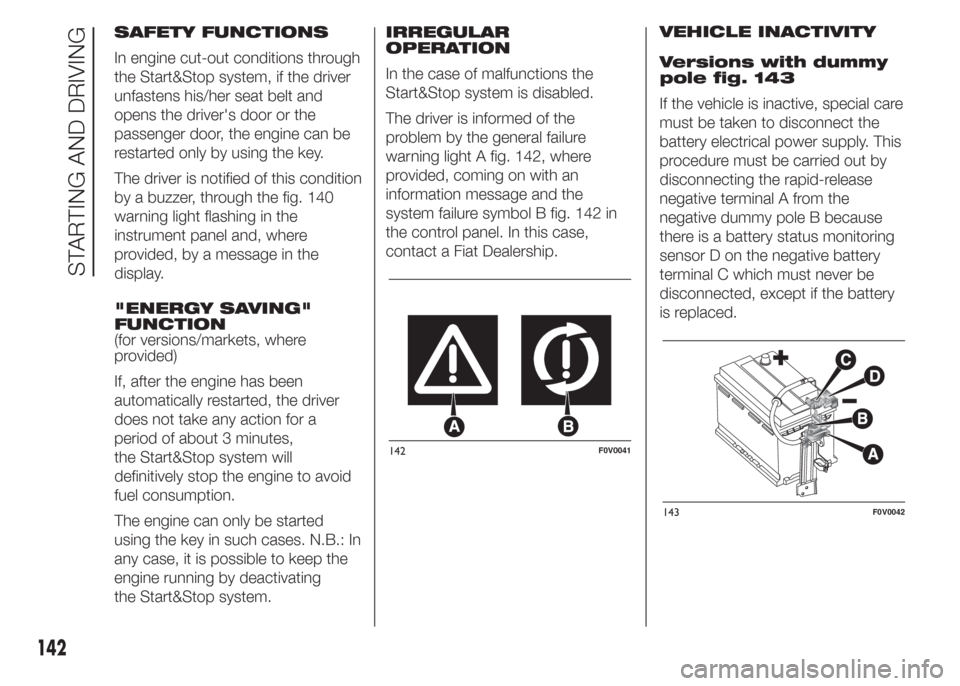
SAFETY FUNCTIONS
In engine cut-out conditions through
the Start&Stop system, if the driver
unfastens his/her seat belt and
opens the driver's door or the
passenger door, the engine can be
restarted only by using the key.
The driver is notified of this condition
by a buzzer, through the fig. 140
warning light flashing in the
instrument panel and, where
provided, by a message in the
display.
"ENERGY SAVING"
FUNCTION
(for versions/markets, where
provided)
If, after the engine has been
automatically restarted, the driver
does not take any action for a
period of about 3 minutes,
the Start&Stop system will
definitively stop the engine to avoid
fuel consumption.
The engine can only be started
using the key in such cases. N.B.: In
any case, it is possible to keep the
engine running by deactivating
the Start&Stop system.IRREGULAR
OPERATION
In the case of malfunctions the
Start&Stop system is disabled.
The driver is informed of the
problem by the general failure
warning light A fig. 142, where
provided, coming on with an
information message and the
system failure symbol B fig. 142 in
the control panel. In this case,
contact a Fiat Dealership.VEHICLE INACTIVITY
Versions with dummy
pole fig. 143
If the vehicle is inactive, special care
must be taken to disconnect the
battery electrical power supply. This
procedure must be carried out by
disconnecting the rapid-release
negative terminal A from the
negative dummy pole B because
there is a battery status monitoring
sensor D on the negative battery
terminal C which must never be
disconnected, except if the battery
is replaced.
142F0V0041
143F0V0042
142
STARTING AND DRIVING
Page 147 of 323
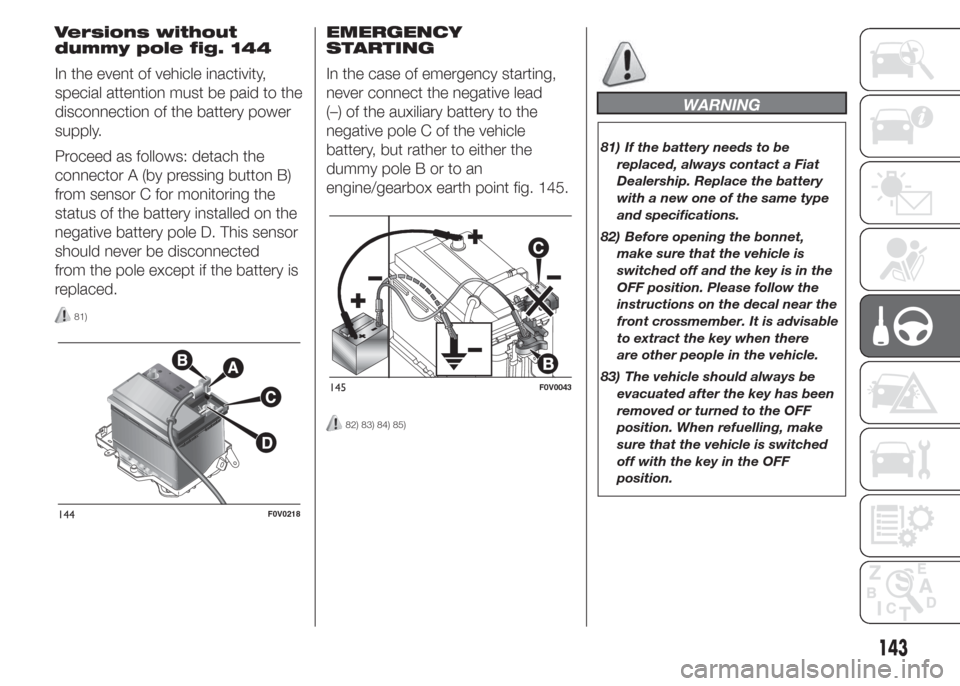
Versions without
dummy pole fig. 144
In the event of vehicle inactivity,
special attention must be paid to the
disconnection of the battery power
supply.
Proceed as follows: detach the
connector A (by pressing button B)
from sensor C for monitoring the
status of the battery installed on the
negative battery pole D. This sensor
should never be disconnected
from the pole except if the battery is
replaced.
81)
EMERGENCY
STARTING
In the case of emergency starting,
never connect the negative lead
(–) of the auxiliary battery to the
negative pole C of the vehicle
battery, but rather to either the
dummy pole B or to an
engine/gearbox earth point fig. 145.
82) 83) 84) 85)
WARNING
81) If the battery needs to be
replaced, always contact a Fiat
Dealership. Replace the battery
with a new one of the same type
and specifications.
82) Before opening the bonnet,
make sure that the vehicle is
switched off and the key is in the
OFF position. Please follow the
instructions on the decal near the
front crossmember. It is advisable
to extract the key when there
are other people in the vehicle.
83) The vehicle should always be
evacuated after the key has been
removed or turned to the OFF
position. When refuelling, make
sure that the vehicle is switched
off with the key in the OFF
position.
144F0V0218
145F0V0043
143
Page 149 of 323
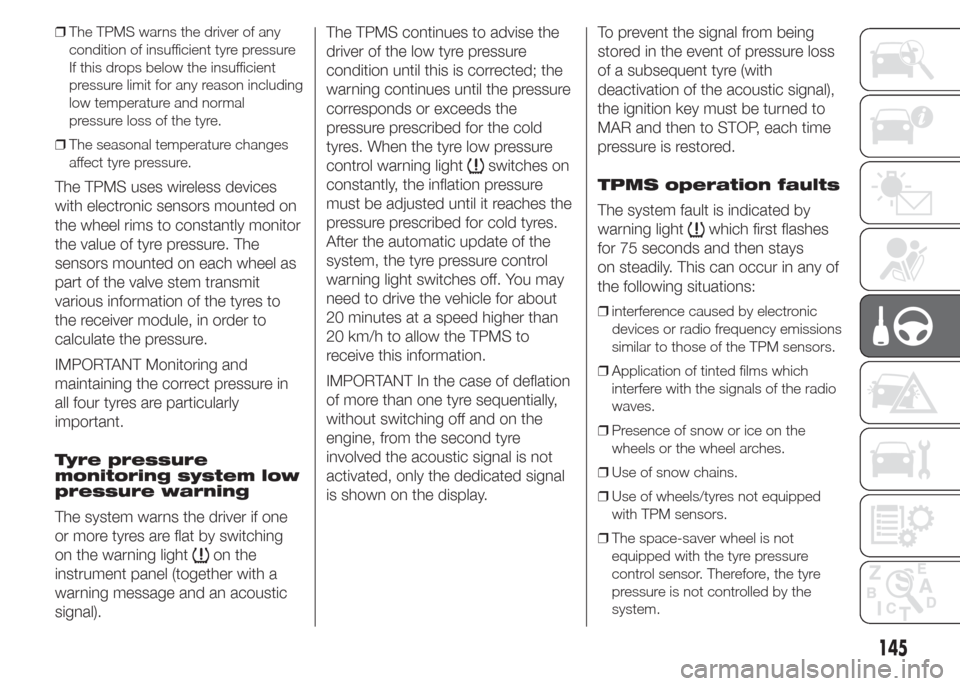
❒The TPMS warns the driver of any
condition of insufficient tyre pressure
If this drops below the insufficient
pressure limit for any reason including
low temperature and normal
pressure loss of the tyre.
❒The seasonal temperature changes
affect tyre pressure.
The TPMS uses wireless devices
with electronic sensors mounted on
the wheel rims to constantly monitor
the value of tyre pressure. The
sensors mounted on each wheel as
part of the valve stem transmit
various information of the tyres to
the receiver module, in order to
calculate the pressure.
IMPORTANT Monitoring and
maintaining the correct pressure in
all four tyres are particularly
important.
Tyre pressure
monitoring system low
pressure warning
The system warns the driver if one
or more tyres are flat by switching
on the warning light
on the
instrument panel (together with a
warning message and an acoustic
signal).The TPMS continues to advise the
driver of the low tyre pressure
condition until this is corrected; the
warning continues until the pressure
corresponds or exceeds the
pressure prescribed for the cold
tyres. When the tyre low pressure
control warning light
switches on
constantly, the inflation pressure
must be adjusted until it reaches the
pressure prescribed for cold tyres.
After the automatic update of the
system, the tyre pressure control
warning light switches off. You may
need to drive the vehicle for about
20 minutes at a speed higher than
20 km/h to allow the TPMS to
receive this information.
IMPORTANT In the case of deflation
of more than one tyre sequentially,
without switching off and on the
engine, from the second tyre
involved the acoustic signal is not
activated, only the dedicated signal
is shown on the display.To prevent the signal from being
stored in the event of pressure loss
of a subsequent tyre (with
deactivation of the acoustic signal),
the ignition key must be turned to
MAR and then to STOP, each time
pressure is restored.
TPMS operation faults
The system fault is indicated by
warning light
which first flashes
for 75 seconds and then stays
on steadily. This can occur in any of
the following situations:
❒interference caused by electronic
devices or radio frequency emissions
similar to those of the TPM sensors.
❒Application of tinted films which
interfere with the signals of the radio
waves.
❒Presence of snow or ice on the
wheels or the wheel arches.
❒Use of snow chains.
❒Use of wheels/tyres not equipped
with TPM sensors.
❒The space-saver wheel is not
equipped with the tyre pressure
control sensor. Therefore, the tyre
pressure is not controlled by the
system.
145
Page 153 of 323
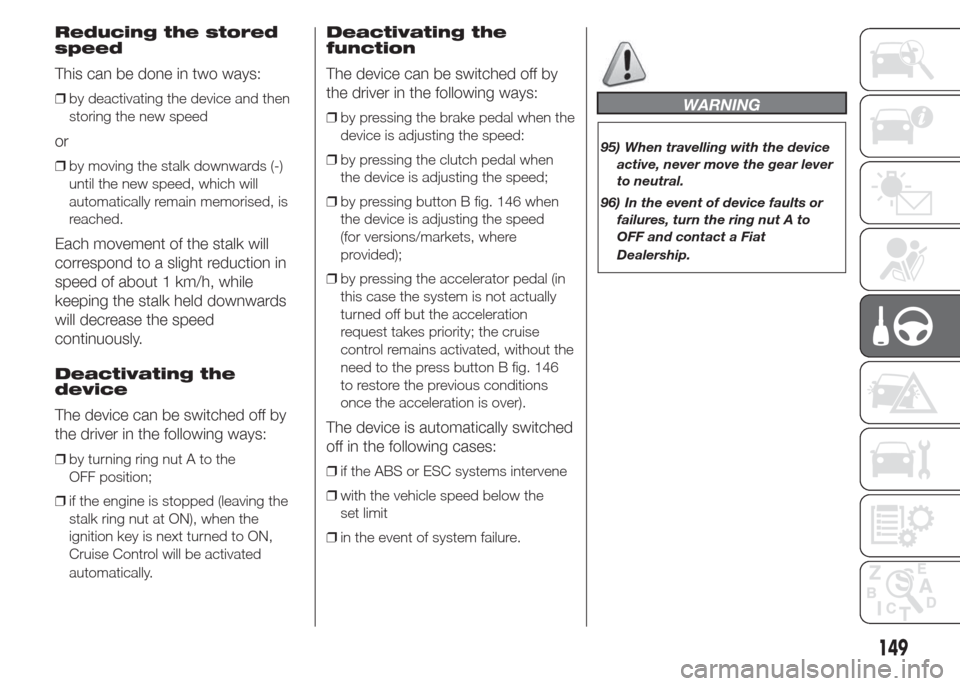
Reducing the stored
speed
This can be done in two ways:
❒by deactivating the device and then
storing the new speed
or
❒by moving the stalk downwards (-)
until the new speed, which will
automatically remain memorised, is
reached.
Each movement of the stalk will
correspond to a slight reduction in
speed of about 1 km/h, while
keeping the stalk held downwards
will decrease the speed
continuously.
Deactivating the
device
The device can be switched off by
the driver in the following ways:
❒by turning ring nut A to the
OFF position;
❒if the engine is stopped (leaving the
stalk ring nut at ON), when the
ignition key is next turned to ON,
Cruise Control will be activated
automatically.
Deactivating the
function
The device can be switched off by
the driver in the following ways:
❒by pressing the brake pedal when the
device is adjusting the speed:
❒by pressing the clutch pedal when
the device is adjusting the speed;
❒by pressing button B fig. 146 when
the device is adjusting the speed
(for versions/markets, where
provided);
❒by pressing the accelerator pedal (in
this case the system is not actually
turned off but the acceleration
request takes priority; the cruise
control remains activated, without the
need to the press button B fig. 146
to restore the previous conditions
once the acceleration is over).
The device is automatically switched
off in the following cases:
❒if the ABS or ESC systems intervene
❒with the vehicle speed below the
set limit
❒in the event of system failure.
WARNING
95) When travelling with the device
active, never move the gear lever
to neutral.
96) In the event of device faults or
failures, turn the ring nut A to
OFF and contact a Fiat
Dealership.
149
Page 157 of 323
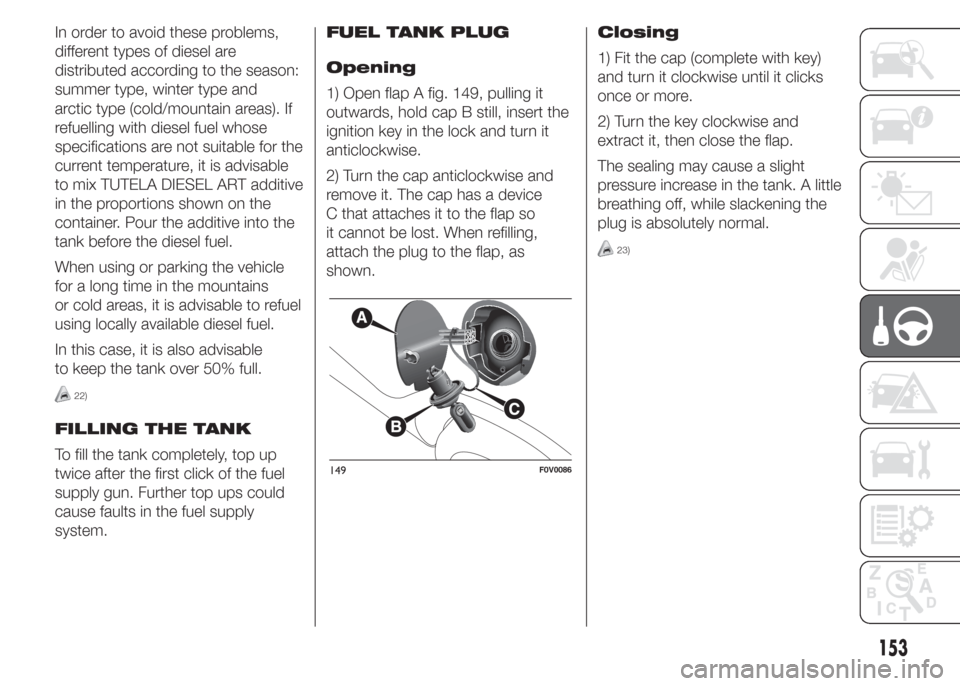
In order to avoid these problems,
different types of diesel are
distributed according to the season:
summer type, winter type and
arctic type (cold/mountain areas). If
refuelling with diesel fuel whose
specifications are not suitable for the
current temperature, it is advisable
to mix TUTELA DIESEL ART additive
in the proportions shown on the
container. Pour the additive into the
tank before the diesel fuel.
When using or parking the vehicle
for a long time in the mountains
or cold areas, it is advisable to refuel
using locally available diesel fuel.
In this case, it is also advisable
to keep the tank over 50% full.
22)
FILLING THE TANK
To fill the tank completely, top up
twice after the first click of the fuel
supply gun. Further top ups could
cause faults in the fuel supply
system.FUEL TANK PLUG
Opening
1) Open flap A fig. 149, pulling it
outwards, hold cap B still, insert the
ignition key in the lock and turn it
anticlockwise.
2) Turn the cap anticlockwise and
remove it. The cap has a device
C that attaches it to the flap so
it cannot be lost. When refilling,
attach the plug to the flap, as
shown.Closing
1) Fit the cap (complete with key)
and turn it clockwise until it clicks
once or more.
2) Turn the key clockwise and
extract it, then close the flap.
The sealing may cause a slight
pressure increase in the tank. A little
breathing off, while slackening the
plug is absolutely normal.
23)
149F0V0086
153
Page 164 of 323
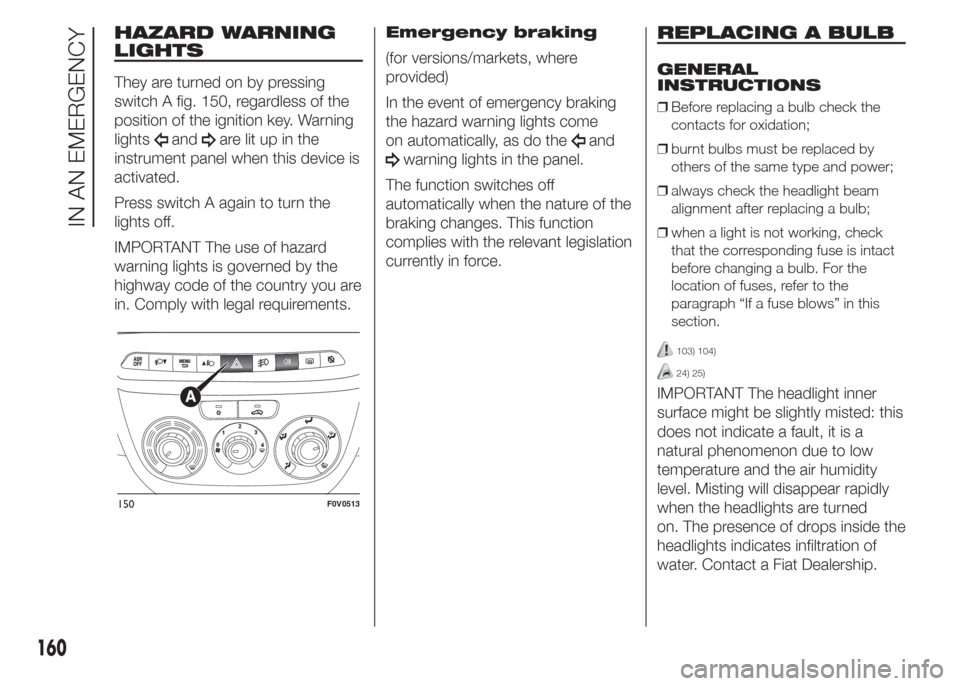
HAZARD WARNING
LIGHTS
They are turned on by pressing
switch A fig. 150, regardless of the
position of the ignition key. Warning
lights
andare lit up in the
instrument panel when this device is
activated.
Press switch A again to turn the
lights off.
IMPORTANT The use of hazard
warning lights is governed by the
highway code of the country you are
in. Comply with legal requirements.Emergency braking
(for versions/markets, where
provided)
In the event of emergency braking
the hazard warning lights come
on automatically, as do theand
warning lights in the panel.
The function switches off
automatically when the nature of the
braking changes. This function
complies with the relevant legislation
currently in force.
REPLACING A BULB
GENERAL
INSTRUCTIONS
❒Before replacing a bulb check the
contacts for oxidation;
❒burnt bulbs must be replaced by
others of the same type and power;
❒always check the headlight beam
alignment after replacing a bulb;
❒when a light is not working, check
that the corresponding fuse is intact
before changing a bulb. For the
location of fuses, refer to the
paragraph “If a fuse blows” in this
section.
103) 104)
24) 25)
IMPORTANT The headlight inner
surface might be slightly misted: this
does not indicate a fault, it is a
natural phenomenon due to low
temperature and the air humidity
level. Misting will disappear rapidly
when the headlights are turned
on. The presence of drops inside the
headlights indicates infiltration of
water. Contact a Fiat Dealership.
150F0V0513
160
IN AN EMERGENCY
Page 178 of 323
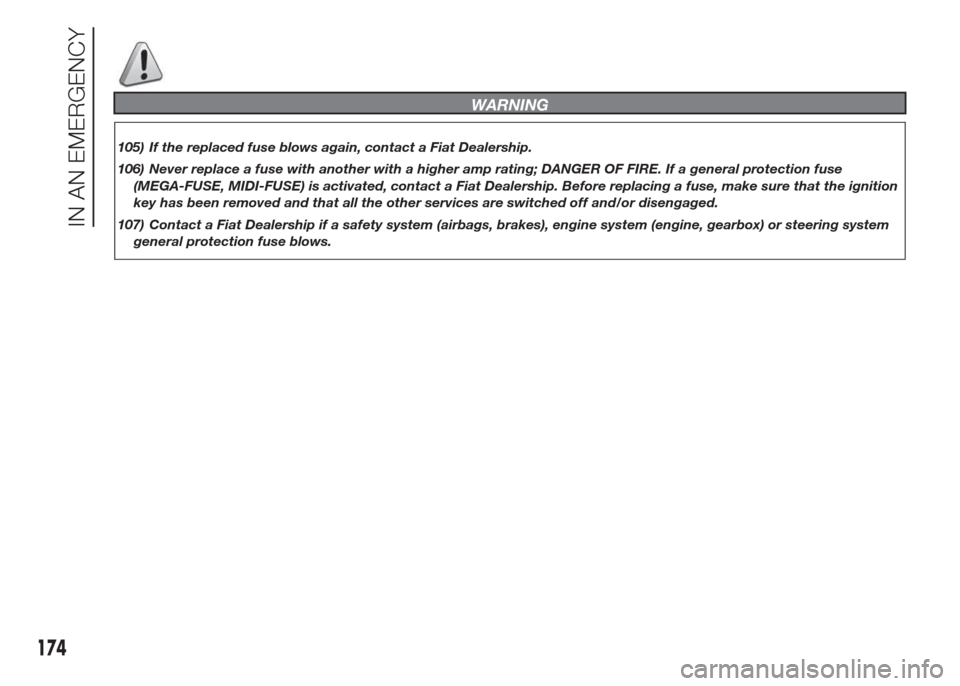
WARNING
105) If the replaced fuse blows again, contact a Fiat Dealership.
106) Never replace a fuse with another with a higher amp rating; DANGER OF FIRE. If a general protection fuse
(MEGA-FUSE, MIDI-FUSE) is activated, contact a Fiat Dealership. Before replacing a fuse, make sure that the ignition
key has been removed and that all the other services are switched off and/or disengaged.
107) Contact a Fiat Dealership if a safety system (airbags, brakes), engine system (engine, gearbox) or steering system
general protection fuse blows.
174
IN AN EMERGENCY
Page 189 of 323

FUEL CUT-OFF
SYSTEM
This intervenes in the case of an
impact causing:
❒the fuel supply cut-off with the engine
consequently switching off;
❒the automatic unlocking of the doors;
❒the switching on of the interior lights;
❒switching on of the hazard warning
lights (to deactivate the lights press
the dedicated button on the
dashboard).
122)
When the system has been
triggered, the message “Fuel cut off,
see handbook” is displayed on
some versions.
Check carefully for fuel leaks, for
instance in the engine compartment,
under the vehicle or near the tank
area.
After a collision, turn the ignition key
to STOP to prevent the battery
from running down.
The following procedure should be
carried out to restore the correct
operation of the vehicle:
❒turn the ignition key to the MAR
position;❒activate the right direction indicator;
❒deactivate the right direction
indicator;
❒activate the left direction indicator;
❒deactivate the left direction indicator;
❒activate the right direction indicator;
❒deactivate the right direction
indicator;
❒activate the left direction indicator;
❒deactivate the left direction indicator;
❒turn the ignition key to the OFF
position.
WARNING
122) If, after an impact, you smell
fuel or notice leaks from the fuel
supply system, do not reactivate
the system to avoid the risk of fire.
LIFTING THE
VEHICLE
If the vehicle needs to be lifted, go
to a Fiat Dealership which is
equipped with the arm hoist or
workshop lift.
185